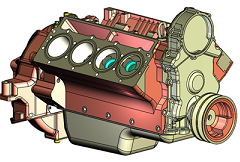SpeedPak creates a simplified
configuration of an assembly without losing references. If you work with very large and
complex assemblies, using a SpeedPak configuration can significantly improve performance
while working in the assembly and its drawing.
Improvements in assembly performance are most noticeable in very
large and complex assemblies.
A SpeedPak configuration is essentially a subset of the parts, faces, reference
geometry, sketches, and curves of an assembly. Unlike regular configurations, where you
can simplify an assembly only by suppressing components, SpeedPak simplifies without suppressing. Therefore, you can substitute
a SpeedPak configuration for the full assembly in higher level assemblies without losing
references. Because only a subset of the parts, faces, reference geometry, sketches, and
curves
are used, memory usage is reduced, which can increase performance of
many operations.
When you make changes to an assembly, such as adding, deleting, or
moving components, the changes are not automatically incorporated into the SpeedPak
configuration, even when you rebuild the assembly. You must manually update the
SpeedPak configuration to incorporate the changes.
When to Use SpeedPak
Use SpeedPak when you want to
insert a complex large assembly into a higher level assembly, especially if you want
to see the entire SpeedPak assembly, but need to mate and dimension only to
relatively few locations.
You can also use SpeedPak to facilitate file sharing. The SpeedPak
information is saved entirely within the assembly file. Therefore, when sharing an
assembly, you can send just the assembly file. You do not need to include component
files.
For example, suppose you design an engine assembly, and need to send
it to your customer's design team so they can insert it in their vehicle
design.

- You create a SpeedPak configuration of the engine assembly,
including all the faces, bodies, reference geometry, sketches, and curves your
customer plans to reference in their vehicle model.
- You send them just the engine assembly file. You do not need to
send files for any of the engine component parts.
- They insert your engine assembly file into their vehicle
assembly file. They can add mates and dimensions to all the items you included
in the SpeedPak definition.
SpeedPak in Drawings
When you dimension SpeedPak configurations in drawings, you can only
dimension to edges included in the SpeedPak, which are shown in black. Edges not
included in the SpeedPak are shown in gray. When you print the drawing, all the
lines print in black, unless you select Color / Gray
scale in the Page Setup dialog
box.
Exporting to DXF/DWG files
is
not supported for SpeedPak drawings.

In a drawing document, when you create a bill of materials for an
assembly whose active configuration is a SpeedPak configuration, you can include
columns for other configurations in addition to the SpeedPak configuration.
In an assembly document, when you create
a bill of materials for an assembly whose active configuration is a SpeedPak
configuration, you can include only the active SpeedPak configuration in the
BOM.
You can use Balloon
 (Annotations toolbar) to add
balloons to all items in a SpeedPak assembly, but the Auto Balloon command is not supported.
(Annotations toolbar) to add
balloons to all items in a SpeedPak assembly, but the Auto Balloon command is not supported.